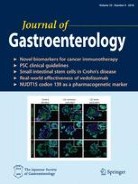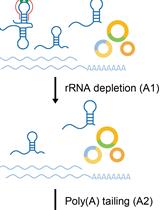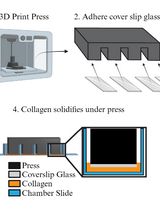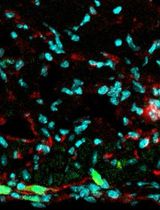- EN - English
- CN - 中文
Fluidigm Based Single-cell Gene Expression Library Preparation from Patient-derived Small Intestinal Organoids
基于Fluidigm的源于患者小肠类器官单细胞基因表达文库的制备
发布: 2020年10月05日第10卷第19期 DOI: 10.21769/BioProtoc.3775 浏览次数: 4584
评审: Tomohiro MizutaniShinya SugimotoJiamin Chen
Abstract
In this protocol, we describe our methods to isolate crypts from patients' biopsy samples and to culture human intestinal stem cells as it’s called “organoid.” Beyond that, we describe how to dissociate organoids cells into single cells for single-cell analysis as a further application. This protocol should provide investigators sufficient tools to generate human organoids from biopsy samples and to accomplish a stable in-vitro assay system.
Keywords: Organoid (类器官)Background
The intestinal epithelium is a multifunctional tissue that orchestrates homeostasis and forms a physical barrier. Each intestinal epithelial cells (IECs) arising from intestinal stem cells (ISCs) renew this epithelium every 4-5 days (Crosnier et al., 2006). ISCs are located at the bottom of the crypts and express specific markers as previously reported by various papers (Muñozet al., 2012; Clevers, 2013). Studies suggested that malfunctions of proper renewals of stem cells are related to intestinal disorders, and understandings of ISCs dynamic may elucidate the pathogenesis of various disorders including Inflammatory Bowel Disease (IBD) (Okamoto et al., 2016).
However, the studies of intestinal stem cell properties had been challenging due to the lack of efficient models that recapitulates physiological intestinal epithelial layers. The epic introduction of “organoid" has overcome various obstacles (Sato et al., 2009 and 2011). Organoids can be established from a single ISC in vitro, and faithfully retain the physiological and pathological features of their tissue of origin (Middendorp et al., 2014). Organoids have been used to dissect underlying pathologic changes in various gastrointestinal disease (Fatehullah et al., 2016; Noben et al., 2017) and has shown potentials to reflect complexed mechanisms of organs.
Also, recent advances in molecular biology techniques allow us to study single-cell modalities (Stuart and Satija, 2019). These techniques developed to have insights into each single cell diversities yet had known to be homogenous populations. Studies have shown that a heterogeneous group of cells share these ISC properties, and constitute a hierarchy within the ISC population (Smith et al., 2016). Furthermore, organoids can be one of the ideal tools that are consist of mostly stem cells and transit-amplifying cells under the undifferentiated culture. In the previous report, a single-cell analysis displayed this heterogeneity among the mouse small intestinal stem cells (Li et al., 2014). Combining organoid culture technique and single-cell analysis has the potential to open a new horizon toward the understandings of the dynamics of human intestinal stem cells. In this protocol, we describe in detail the work-flow of human intestinal organoids establishment and dissociation into single cells for further various applications. Compared to those protocols using scRNA-seq (Biton et al., 2014), the present protocol using multiplex PCR enables acquiring single cell profiles in a low-cost, short-time basis, while the number of cells and genes will be limited by the capacity of the microfluid chip format.
Materials and Reagents
- Organoid culture
- 24-well Tissue Culture Plate (Corning, Falcon, catalog Number: 353226 )
- 50 ml and 15 ml Conical centrifuge tubes (Corning, Falcon, catalog numbers: 352096 , 352070 )
- 15 ml STEMFULLTM low cell adhesion tube (Sumitomo Bakelite Co., catalog number: MS-90150Z )
- 1.5 ml Eppendorf tube (Eppendorf Safe-Lock Tubes, catalog number: 00 30121023 )
- 70 μm Cell strainer (Corning, Falcon, catalog number: 352350 )
- Patient intestinal biopsy samples obtained by endoscopies
- Phosphate Buffered Saline (PBS) (Sigma, catalog number: D8537-500ML ) (stored at 4 °C)
- Matrigel (Corning, catalog number: 356231 ) (stored at 4 °C)
- Cell recovery solution (Corning, Thermo Fisher Scientific, catalog number: 354253 ) (stored at 4 °C)
- Advanced-DMEM (Thermo Fisher Scientific, catalog number: 12491015 ) (stored at 4 °C)
- Penicillin/Streptomycin (Nacalai Tesque, catalog number: 26253-84 ) (stored at 4 °C)
- 1 mol/l-HEPES Buffer Solution (Nacalai Tesque, catalog number: 17557-94 ) (stored at 4 °C)
- GlutaMAXTM-I (100x) (Gibco, Thermo Fisher Scientific, catalog number: 35050-061 ) (stored at 4 °C)
- 0.5 M EDTA ((Thermo Fisher Scientific, catalog number: AM9260G )
- Trypan blue solution (Thermo Fisher Scientific, catalog number: 15250061 )
- N-acetylcysteine (Sigma, catalog number: A9165-5G ) (stored at -20 °C, 1 M,10 ml aliquot)
- Gastrin I (Sigma, catalog number: 3006 ) (stored at -20 °C, 100 µl, 1,000 μl aliquot)
- N2 supplement (R&D Systems, catalog number: AR009 ) (stored at -20 °C,100x, 1 vial)
- B27 supplement (R&D Systems, catalog number: AR008 ) (stored at -20 °C, 50x, 1 vial)
- Recombinant mouse EGF (R&D Systems, catalog number: 2028-EG-200 )
(stored at -20 °C, 20 μg/ml, aliquot 1,000 μl) - Recombinant mouse Noggin (R&D Systems, catalog number: 1967-NG-025/CF ) (stored at -20 °C, 20 μg/ml, aliquot 250 μl)
- Recombinant human R-spondin-1 (R&D Systems, catalog number: 4645-RS ) (stored at -20 °C, 100 μg/ml, aliquot 500 μl)
- Recombinant mouse Wnt-3a (R&D Systems, catalog number: 1324-WN-010/CF ) (stored at -20 °C, 10 μg/ml, aliquot 1,000 μl)
- Nicotinamide (R&D Systems, catalog number: 4106 ) (stored at -20 °C, 1 ml, aliquot 1,000 μl)
Note: Stored in the RT shelf as powder. Nic 6.1 g + ddH2O 50 ml, aliquot 10 ml each into 15 ml Falcon tubes. When you thaw one tube, aliquot 1.5 ml eppentubes and store. - A83-01 (Sigma-Aldrich, catalog number: 2939 ) (stored at -20 °C, 10 mM, 100 μl aliquot)
Note: Protect from light. Aliquot 10 mM dilution into Eppendolf tubes and label them with x20, further dilute 10 mM Eppendolf tube with DMSO and aliquot 100 μl each. - SB202190 (Sigma-Aldrich, catalog number: 1264 ) (stored at 4 °C, 150 μl aliquot)
Note: SB202190 10 mg + DMSO 3,018 μl. Aliquot 150 μl each and freeze at -20 until use. - Y-27632 (R&D Systems, catalog number: 1254 ) (protect from light, stored at -20 °C, 10 mM, 150 μl aliquot)
- Human intestinal basal culture medium (see Recipes)
- Human small intestinal organoid growth media (see Recipes)
- Single-cell analysis
- C1 preamp IFC (10-17 μm, Fluidigm, catalog number: 100-5480 )
- 48 x 48 IFC chip (Fluidigm, catalog number: BMK-M-48.48 )
- TrypLE Select (Thermo Fisher Scientific, catalog number: 12563011 ) (stored at 4 °C)
- C1 Single-Cell Reagent Kit for Preamp (including Module 1, Module 2: Fluidigm, catalog number; 100-5319 ) (stored at -20 °C)
- Single Cell-to-CT kit (Thermo Fisher Scientific, catalog number: 4458236 ) (stored at -20 °C)
- LIVE/DEAD viability/cytotoxicity kit (Thermo Fisher Scientific, catalog number: L3224 ) (stored at -20 °C)
- Pooled primers (see Recipes)
- Lysis final mix (see Recipes)
- RT final mix (see Recipes)
- PreAmp final mix (see Recipes)
- LIVE/DEAD cell staining (see Recipes)
- Biomark HD
Equipment
- Pipettes (5 ml, 10 ml, 25 ml, 50 ml), micro-pipettes (10 μl, 20 μl, 200 μl, 1,000 μl)
- Multi-channel pipette (Mettler Toledo, RAININ, model: E8-20 XLS+, catalog number: 17013798 )
- Centrifuge
- Vortex mixer
- Hemacytometer (Burker-Turk, Fujirika Co., A114)
- 37 °C, 5% CO2 cell culture incubator
- Fluorescence microscope (Keyence, model: BZ-X700 ,)
- C1 single cell auto prep system (Fluidigm, San Francisco, CA, USA)
- C1 single cell auto prep array IFCs (MX) (Fluidigm, San Francisco, CA, USA)
- Biomark HD system (Fluidigm, San Francisco, CA, USA)
Software
- Singular Analysis Toolset Software v3.5.2 (Fluidigm, San Francisco, CA, USA)
- R software
- The Partek Genomic Suite (Version 6.6-6.16.0812, Partek, Chesterfield, MO, USA)
Procedure
文章信息
版权信息
© 2020 The Authors; exclusive licensee Bio-protocol LLC.
如何引用
Suzuki, K. and Okamoto, R. (2020). Fluidigm Based Single-cell Gene Expression Library Preparation from Patient-derived Small Intestinal Organoids. Bio-protocol 10(19): e3775. DOI: 10.21769/BioProtoc.3775.
分类
干细胞 > 成体干细胞 > 肠道干细胞
细胞生物学 > 基于细胞的分析方法 > 基因表达
您对这篇实验方法有问题吗?
在此处发布您的问题,我们将邀请本文作者来回答。同时,我们会将您的问题发布到Bio-protocol Exchange,以便寻求社区成员的帮助。
Share
Bluesky
X
Copy link












